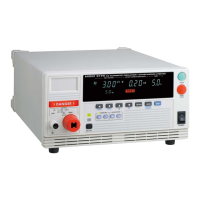3.1 Setting the Test-Conditions
37
3
When setting the voltage-raising time (ramp-up time), the initial value can be set
by setting it as a proportion of the test voltage. The default value is 0.0 and the
initial voltage for ramp-up is 0 V.
3.1.6 Setting the Initial voltage for ramp-up
1.
Press the key to move the flashing cursor to the Initial voltage for
ramp-up.
In the frequency display, a double-digit voltage ratio (proportion of test voltage)
will be shown to indicate the ramp-up initial voltage setting.
2.
Press the / keys to set the Initial voltage for ramp-up.
Setting range: 0.0 to 1.0 (The value changes by 0.1.)
• Setting is not possible when the ramp-up time is OFF.
• When the test is started, a voltage indicated by the test voltage multiplied by
the voltage ratio will be outputted. After that, it will use the pre-set “ramp-up
time” to rise almost linearly until the test voltage is achieved.
3.
Press the STOP key to complete the setting value.
The instrument reverts to the READY state.
To continue to the setting for the next item, press the key.
or
<Ex.> Set the initial voltage as 0.1 times the test voltage
STOP
• Setting is not possible if the ramp-up time timer is not set.
• If the voltage calculated from a proportion of the initial voltage and the pre-set
voltage is less than 100 V, the initial voltage will be 100 V.
• Due to the response time of the circuit, sometimes immediately after the with-
stand voltage test has started, both the time taken for the output voltage to
reach initial voltage of ramp-up and the time taken for the output voltage to
reach the accurate test voltage after the ramp-up time has ended, may take
longer, depending on the loads. As a result, the actual test time will be; time
taken for the output voltage to reach the initial voltage level + setting ramp-up
time + time taken for the output voltage to reach the accurate test voltage level
+ test time + ramp-down time.

